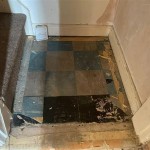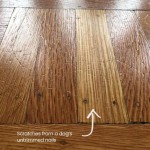Nailing Hardwood Flooring By Hand: A Comprehensive Guide
Installing hardwood flooring is a significant undertaking that can dramatically enhance the aesthetic appeal and value of a property. While pneumatic nailers are commonly employed for their speed and efficiency, the traditional method of nailing hardwood flooring by hand remains a viable and often preferred option for certain situations. This comprehensive guide delves into the nuances of nailing hardwood flooring by hand, exploring the necessary tools, techniques, and considerations involved in achieving a professional-quality result.
The manual approach to hardwood flooring installation offers a level of control and precision that can be advantageous, particularly when working with delicate or expensive wood species. It also eliminates the need for an air compressor and associated noise, potentially making it a suitable choice for noise-sensitive environments. Furthermore, understanding the principles of hand-nailing provides a solid foundation for operating pneumatic nailers effectively, as the core techniques remain fundamentally similar.
Essential Tools and Materials
Successfully nailing hardwood flooring by hand requires a specific set of tools and materials. A well-equipped toolkit will not only streamline the installation process but also ensure the quality and longevity of the finished floor.
Hardwood Flooring Nails: The selection of the correct nail type is paramount. Flooring nails, typically hardened steel with barbed shanks, are specifically designed to grip the wood fibers securely and resist loosening over time. Common sizes range from 1 ½ inches to 2 inches, depending on the thickness of the flooring material. It is essential to consult the flooring manufacturer's recommendations for the appropriate nail size and type.
Nail Set: A nail set is a cylindrical tool with a cupped or pointed end used to countersink the nail head below the surface of the wood. This prevents the nail head from interfering with subsequent flooring boards and allows for a flush, seamless appearance. Nail sets are available in various sizes; a selection is recommended to accommodate different nail head sizes.
Hammer: A high-quality hammer is indispensable. A smooth-faced hammer with a comfortable grip is essential for consistent and controlled nailing. The weight of the hammer should be appropriate for the user's strength and the hardness of the flooring material. A claw hammer is generally preferred, as the claw can be used to remove bent or misplaced nails.
Wood Blocks: These are used to protect the flooring surface during installation. When tapping the flooring boards into place, using a wood block between the hammer and the flooring prevents damage such as denting or splintering.
Measuring Tape: Accurate measurements are crucial for a professional-looking installation. A durable and easy-to-read measuring tape is necessary for determining board lengths, row widths, and overall room dimensions.
Chalk Line: A chalk line is used to create straight and accurate guidelines on the subfloor. These lines serve as visual references for aligning the flooring boards and ensuring a consistent layout.
Moisture Meter: Before installation, it's imperative to ensure that both the hardwood flooring and the subfloor have acclimated to the room's humidity levels. A moisture meter is used to measure the moisture content of the wood, preventing future warping or cupping.
Safety Glasses: Eye protection is non-negotiable when working with hammers and nails. Safety glasses protect against flying debris and accidental injuries.
Knee Pads: Installing hardwood flooring by hand often involves prolonged kneeling. Knee pads provide essential comfort and support, reducing strain on the knees.
Preparing the Subfloor and Flooring
Proper preparation is the foundation for a successful hardwood flooring installation. Neglecting this crucial step can lead to a host of problems, including uneven flooring, squeaks, and premature wear and tear. The focus should be on ensuring a clean, level, and stable subfloor surface.
Subfloor Inspection: Begin by thoroughly inspecting the subfloor for any signs of damage, such as rot, mold, or water stains. Repair any deficiencies before proceeding. Loose subfloor boards should be securely fastened, and any protruding nails or screws should be countersunk.
Subfloor Leveling: The subfloor must be level to within 3/16 inch over a 10-foot span. Use a long level to identify any high or low spots. High spots can be sanded down, while low spots can be filled with a self-leveling compound or shims.
Subfloor Cleaning: Thoroughly clean the subfloor to remove any debris, dust, or adhesives. Use a broom, vacuum cleaner, and scraper as needed. A clean surface ensures proper adhesion of the flooring boards.
Moisture Testing: As previously mentioned, moisture content is a critical factor. Use a moisture meter to measure the moisture content of both the subfloor and the hardwood flooring. Aim for a moisture content difference of no more than 2-4% between the two materials. Allow the flooring to acclimate to the room's environment for several days or even weeks before installation.
Underlayment (Optional): Depending on the subfloor type and the desired level of sound insulation, an underlayment may be installed between the subfloor and the hardwood flooring. Consult the flooring manufacturer's recommendations for appropriate underlayment options.
Layout Planning: Before commencing the installation, carefully plan the layout of the flooring. Determine the direction of the boards and consider any potential obstacles, such as doorways or pipes. Start with a full row along the longest, straightest wall, ensuring that the boards are parallel to the wall.
The Hand-Nailing Technique
Once the subfloor and flooring are properly prepared, the actual hand-nailing process can begin. Precision and attention to detail are key to achieving a professional-looking and long-lasting result.
Positioning the First Row: Carefully position the first row of flooring boards along the chalk line, leaving a small expansion gap (typically ¼ to ½ inch) between the boards and the wall. This gap allows for natural expansion and contraction of the wood due to changes in humidity.
Nailing the First Row: Using the appropriate size flooring nails, drive the nails at a 45-degree angle through the tongue of the board and into the subfloor. Space the nails approximately 6 to 8 inches apart along the length of the board. The first row, due to its exposed nature, may require face-nailing near the wall. Countersink these nails using the nail set.
Securing Subsequent Rows: After the first row is secured, continue installing subsequent rows, interlocking the tongues and grooves of the boards. Use a wood block to gently tap the boards into place, ensuring a tight and seamless fit. Again, drive the nails at a 45-degree angle through the tongue of each board.
Countersinking Nails: After each nail is driven, use the nail set to countersink the nail head slightly below the surface of the wood. This prevents the nail head from interfering with subsequent boards and allows for a smooth, even surface.
Staggering End Joints: To enhance the structural integrity and aesthetic appeal of the floor, stagger the end joints of the boards. Avoid creating continuous lines of end joints, as this can weaken the floor and detract from its visual appeal.
Addressing Obstacles: When encountering obstacles such as doorways or pipes, carefully cut the flooring boards to fit around the obstacle. Use a jigsaw or other appropriate cutting tool to achieve a precise and clean cut.
The Last Row: The final row of flooring boards may need to be cut to fit the remaining space. Remember to maintain the expansion gap between the boards and the wall. Face-nailing and countersinking will likely be necessary for the final row.
Final Inspection: Once the installation is complete, conduct a thorough inspection of the floor. Check for any loose boards, protruding nails, or uneven surfaces. Make any necessary adjustments or repairs. Clean the floor thoroughly to remove any dust or debris.
Mastering the art of nailing hardwood flooring by hand requires practice, patience, and attention to detail. By following these guidelines and employing the proper tools and techniques, it is possible to achieve a beautiful and durable hardwood floor that will enhance the value and enjoyment of any home.

How To Install Hardwood Flooring Young House Love

How To Install Wood Flooring Lowe S

The Top Tools You Need For Installing Hardwood Floors From Forest Llc

The Art Of Hand Sanding For A Smooth Floor Finish Mr Sander

How To Install Hardwood Flooring Young House Love

How To Install Hardwood Flooring Like A Pro

The Art Of Hand Sanding For A Smooth Floor Finish Mr Sander

How To Install A Hardwood Floor Build This Weekend

Recommended Hand Tools For Fitting Wood Flooring And Beyond Blog

How To Install A Hardwood Floor Build This Weekend
Related Posts








